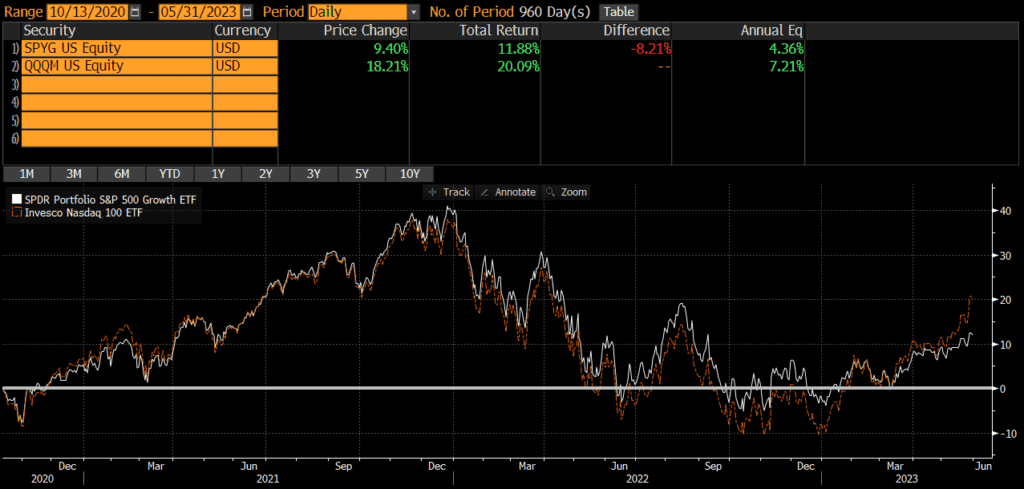SPYG and QQQM are two of the most popular ETFs in the market. Given their popularity, many people compare SPYG vs QQQM and/or ask which fund is a better investment.
My answer to these types of questions is that SPYG and QQQM are very different and not necessarily comparable. So rather than write a long post about similarities and differences between SPYG and QQQM, I’ll provide a framework for thinking about SPYG vs QQQM.
My goal here at ThoughtfulFinance.com is to educate investors and that sometimes includes not answering the exact question that was asked, reframing questions, or providing a different type of answer. As always though, a quick reminder that this site does NOT provide investment recommendations. Fund comparisons (such as this one) are not conducted to identify the “best” fund (since that will vary from investor to investor based on investor-specific factors).
The Short Answer
On the surface, SPYG and QQQM look similar as they’re both large-cap growth-oriented funds. They have very different exposures, although that has not led to meaningful differences in volatility. That being said, QQQM has outperformed by a wide margin since inception. Yet, I would not use either fund as a core position, but they could be used as satellite positions.
Types of Investors
There are a few reasons that someone might want to know whether SPYG or QQQM is a better investment and I think it has a lot to do with who they are. Different types of investors have varying levels of knowledge, differing goals, and so on.
New Investors
Even though SPYG and QQQM are not necessarily comparable, individual investors may not necessarily understand that the funds are different or what differences really matter. New investors may want to just skip to the bottom of this post.
Average Investors
Some investors may understand that SPYG and QQQM are quite different, but may be interested in selecting the one that they believe will perform the best. My response to these investors is that portfolio construction should be based on a target asset allocation (based on risk tolerance, time horizon, liquidity needs, and so on). Once an allocation is selected, then investors can select the best vehicle for each slice of the portfolio allocation. If an investor decides on an asset allocation before selecting investments (as they should!), then the question of SPYG vs QQQM will never come up since they fill different roles in a portfolio.
Day Traders
There are some people who think that they can trade in and out of SPYG, QQQM, and other investments profitably. To those people, I’d say the research, evidence, and odds are stacked against you but good luck!
SPYG vs QQQM: Holdings & Exposures
SPYG and QQQM are not comparable because their underlying holdings are so different. An investor’s preference for SPYG or QQQM will depend on its role in the portfolio.
Both funds primarily hold stocks, but the composition and exposures of their holdings is very different. Although both SPYG and QQQM are large-cap growth funds, QQQM is more concentrated in terms of number of companies and sectors. However, this concentration has not necessarily hurt QQQM relative to SPYG. QQQM has underperformed SPYG in some periods, but not always. SPYG has underperformed QQQM since inception (see SPYG vs QQQM historical performance chart below).
All of that being said, QQQM and SPYG are more volatile than a broad-based index fund such as VTI or IVV. I would never recommend SPYG or QQQM as a core portfolio holding. At best, they could be satellite or complementary positions.
SPYG vs QQQM: Performance, Expenses, & Risk
I could compare SPYG and QQQM’s historical performance, expense ratios, tax-efficiency, and so on as many sites do. However, these details are only important points of comparison if the funds are comparable, so this post doesn’t include a bunch of meaningless data. Those who are still interested can check out ETF.com’s comparison tool.
Historical Performance
Since SPYG and QQQM have very different holdings and exposures, comparing historical performance is meaningless. One fund will outperform over certain time periods and the other will outperform over other time periods. I am not going to delve into a performance comparison and attribution, since we already know that the funds are very different. Readers who really want this information can check out tools like Morningstar.com.

Expenses
Again, any performance difference caused by the expense ratios of SPYG and QQQM will be dwarfed by larger differences like holdings, exposures, risk factors, etc. Expenses are very important when all else is equal, but SPYG and QQQM are not equal at all!
Risk & Volatility
The two funds are very different, but the risk and volatility has not been that different historically.
ETF Benefits
Both SPYG and QQQM are exchange-traded funds (ETFs), which do have some advantages for investors.
Tax Efficiency
ETFs are typically more tax-efficient than mutual funds, due to their ability to avoid realizing capital gains through like-kind redemptions (a process that is beyond the scope of this post). Thus, these funds are about as tax-efficient as any fund can be and either fund is appropriate in taxable accounts.
Tradability
ETFs are free to trade on many platforms and investors should have no problem trading SPYG or QQQM, which are large and liquid.
Alternative Vehicles
Investors limited to mutual funds should have no problem finding a mutual fund version of SPYG or a mutual fund version of QQQM.
Investors planning to allocate more than $250,000 may consider direct indexing rather than an ETF or mutual fund, especially if they are in a high tax bracket. Any institutional direct indexer should be able to replicate SPYG or QQQM easily.
What Would I Do: SPYG or QQQM?
In my opinion, neither SPYG nor QQQM is appropriate as a core holding for most portfolios. However, I think either QQQM or SPYG could potentially be a satellite holding for some investors. For a core holding, I’d use something like VTI.